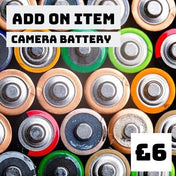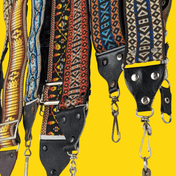
8 Photography Tips For Beginners
Have you ever wanted to try and take photos like celebrities or influencers on their holidays looking effortlessly candid with fuzzy cute photos? Do you fancy getting cute photos of you and your friends but can't make it look like it doesn't come straight from your iPhone? That classic fuzzy, dreamy look comes from using the magic of film!
Here are 8 tips from Film Camera Store to give you a head start with achieving those Insta-ready photos.

@dianasfilmdiary - Diana Silvers captures film with her co-stars from Ma and Booksmart

Photo by Jasmine Hanna Otto on Unsplash
Tip 1
Develop your film professionally
Developing your film professionally can help you to achieve the photos you really want. Film photography is not as complicated as you may have been told. A lot of influencers use disposable cameras, but this is harmful to the environment in that it creates single-use plastic. Using one of our cameras or another reusable camera. As a beginner using and becoming familiar with your local development lab can be helpful as you can understand the process and get amazing results.

Tip 2
Choosing the right film
With film photography, you have a massive opportunity to try different films and experiment with different formats too. The best tip we can give is to start with the most versatile film format possible. This is 35mm. 35mm film is the standard photographic format used for both SLRs and Movie films.

The different formats for film can help you to explore what film is like to use. When you start using film for the first time it can be tricky to understand it and you may have multiple photos or even a roll that doesn't turn out exactly how you wanted it to. It's all about experimenting with it and trying out settings to get you that perfect photo. Try our blog about perfect photos to understand a bit more about settings.
Tip 3
Start with a cheap film and camera
It's easy to get carried away with all the choices of film cameras and accessories and flashes and film and... Yeah. Take a second and remember why you want to start using film photography in the first place. You are curious and just want to try it out. So go with something cheap and affordable with some easy film to start and you're well away. It's perfect to start a new little hobby and before you know it you will understand why there are so many choices to make with what camera to choose.
DONT overcomplicate it. Our Vibe bundles are a brilliant start into film photography as they are the perfect price to commit to and have an in-built flash along side 2 rolls of film to get you started.
Pink Vibe Bundle - £89.99
Alternatively, if you want a better result and the knowledge that the photos will at least be in focus, stay on the cheaper side of a point-and-shoot camera. These often have in-built flashes too but also have autofocus as opposed to a fixed focus. A fixed focus means you have 1 point of focus at a specific range. This is often found in a disposable, where it tells you to always be at least 1-3 meters away from what you are photographing... sound familiar? Well, autofocus can automatically adjust the focus and make sure you and your friends are in the photo notably in focus.
Try out a cheaper Point and Shoot such as a Carena Super Zoom 105 or as we like to call it, Fuzzy Logic
This camera is a perfect starter camera at a cheap price to let you experiment to your hearts content! <3
Carena Super Zoom 105 - £99.99
Tip 4
Get a grip on your settings
Taking photos on film is always a gamble and can put people off because the average person doesn't really use a DSLR or a camera on manual settings. Most of us use our phones to take photos, so having to figure out the photography jargon can be a real task in itself. Like learning a language you become more proficient with practice. It's all about experimenting with what you have and letting go a little. A top tip from us is to take the photo you want using your phone in "professional mode" meaning you can see all the settings changing the photo. Once you have the perfect settings for how you want your photo to look, transfer these to your film camera by setting the shutter speed, exposure, and aperture for your lens. This is a handy way to know what your photo will look like when you eventually get it developed.
Another tip would be to write down the settings you use whilst photographing. This helps you when you get your photos back and you like the outcome of the photos you can replicate this again with the same settings.

Photo by Barna Kovács on Unsplash
Tip 5
Try different film stock
Now it's ok using Tip 2 but what if you've done that and the film looks awful and it's just not what you wanted? Feel the need to change things up and use different film stock. You won't know what you like unless you experiment with different types of film. There are so many different film stocks you can use. You don't have to start off with colour film either. I know I didn't. Black and white film are actually specific to film photography as you can't shoot in true black and white with digital cameras. The editing is either done in camera or post-production. This means that when you shoot in black and white film your tonal range is WAY better and bigger!

Photo by Annie Spratt on Unsplash
Tip 6
Expose for the shadows
Ok, the settings are important and once you get used to using manual settings it makes you very in tune with what your camera can do. The problem is when you get them developed you still don't get all the detail you wanted from the whole photo. Maybe the grain is off or maybe the shadows aren't even shadows or the sky is so white it's just not giving you beautiful bright blue sky like it actually was when you took it on your iPhone. A massive tip from us is to underexpose your film for the depth in those shadows. Of course, this is going to give you an overall darker photo, but when you edit these photos you will have a lot more flexibility from colour range to tonal range and grain. Perhaps put your camera down by maybe 1 stop no more than 3 depending on how bright it is where you are shooting.

Photo by Craig Ren on Unsplash
Tip 7
Use a Light meter
Using a Light meter will help you tremendously whilst starting out in film photography. It takes the guesswork out of what settings to use. As you are probably gathering by now, the secret to an Insta-worthy film photo is knowing your settings. So a light meter, how does it work?
Quite simply a light meter works by detecting the amount of light striking either the sensor or the subject. By following the information provided by the light meter, you can select the exposure triangle settings (aperture, shutter speed, ISO) that will result in optimal exposure for your subject.
How to use a light meter
Hold your meter in front of your subject, pointing towards the light that is illuminating them (not towards the camera). Now simply press the metering button to read the light measurement. With multiple light sources, you can measure them individually by pointing the meter toward each one.

Tip 8
Practice makes improvement
















